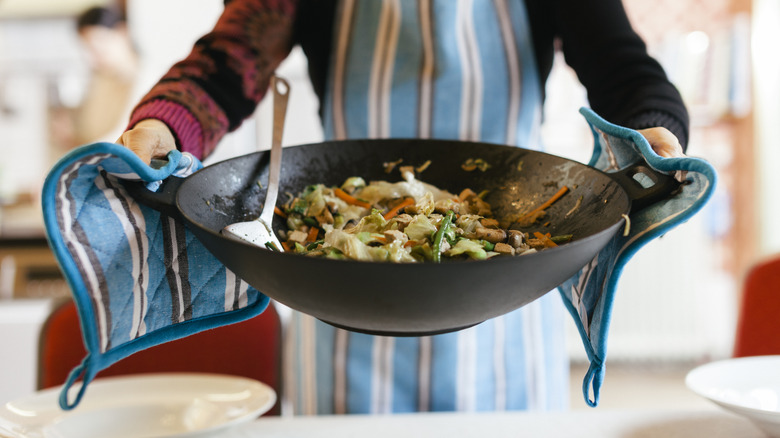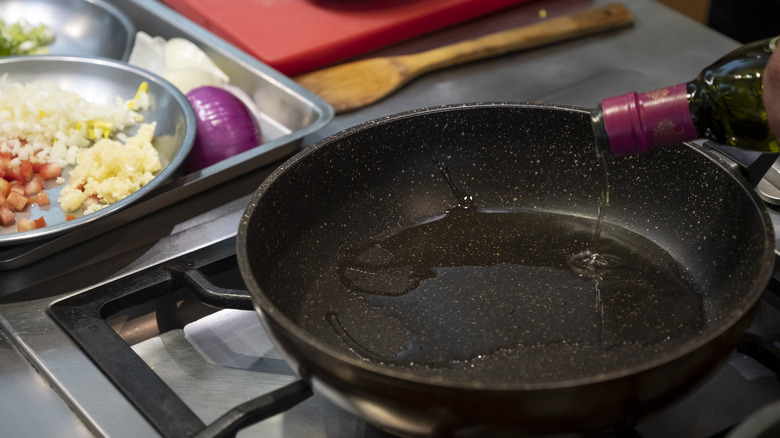Wok Vs Skillet: When To Use Each For The Best Results
As even novice home cooks know, in the kitchen, selecting the right tool for the job can make all the difference. Remember the moment when you learned to cut loaves of bread using a serrated knife rather than desperately hacking into them with a chef's knife? There's a reason why knife blocks come outfitted with an array of different knives for achieving different purposes. The same principle is true of cookware — and so, when is the wok the right tool for the job, and when should home cooks reach for a skillet instead?
With their curved sides and deep body, woks are all about volume. Woks are made for exposure to high heat and, by extension, fast cooking. They supply ample room for stirring or tossing panfuls of ingredients — an ideal tool for crafting evenly cooked stir-fries or any dish in which you want to avoid overcrowding a myriad of ingredients.
By contrast, skillets feature shallow sides and a flat bottom. This design makes skillets perfect for evenly distributing heat and retaining it once hot. That low, flat bottom provides maximum access to the heat source on the stove. When even cooking sans agitation is the name of the game, as with sauteing veggies, cooking a steak, or making pancakes, the skillet is the right tool for the job.
Woks are best for quick cooking over high heat
The wide, domed pot of the wok is all about high heat and expansive surface area. Its wicked fast heat conductivity makes smoking a breeze, imparting a charred flavor to your dishes. This unique flavorful influence is so gastronomically iconic that it has a name of its own: wok hei, meaning the "breath of the wok" in Chinese. Woks are also great for deep-frying thanks to their roomy basin. In short, if you've been wanting to expand your culinary skills and try a new cooking technique, chances are, you can do it with a wok.
Spoiler alert: Woks are the right tool for way more than just stir frying. Use your wok to quickly make taco filling or paella. Or keep the wok off the heat and use that spacious bowl to easily toss a salad or knead bread dough. Over low heat, woks make great tortilla warmers or fondue pots. Pop a bamboo steamer inside that wok, and you can heat restaurant-worthy dumplings in minutes.
Carbon steel woks are ultra-durable high-heat rockstars, though they admittedly require regular seasoning. Non-stick or teflon-coated woks are designed for easy cleanup and require no maintenance but cannot reach the soaring temperatures that carbon steel can handle, making them a less-apt option for smoking. Home cooks with a smooth-topped electric stove will need to opt for a flat-bottomed wok.
Skillets are best for even heat distribution and lower temperatures
Skillets feature the perfect attributes for sauteing and searing, easily browning veggies, meats, and tofu to a savory crisp. Thanks to the wide, flat base, any cooking oil or drippings will fall evenly to the bottom of the pan, helping stave off an oily mess or positively distributing flavorful liquids across the entire meal. Skillets are also better suited for lower temperatures than woks. If you're looking to caramelize onions, cook a thick-cut steak, or if you generally tend to cook over lower temperatures than an open flame, skillets might be the move for you.
You can use a skillet to fry bacon, eggs, and hash browns all in the same pan! You can also fry fish, pan-sear chicken breast, or whip up a killer grilled cheese. Use a skillet to roast Brussels sprouts or make smash burgers. If you have a deeper cast iron skillet, you can use that bad boy to bake cornbread or a fluffy Dutch baby, or even make a shepherd's pie.
Skillets come in a variety of materials from nonstick to cast iron to stainless steel. Heavy, virtually indestructible cast iron skillets are a classic staple for a reason, with their legendary ability to create an effortless sear or crust. But they do require a bit of routine maintenance to keep in good shape. Nonstick and stainless steel pans are better suited for wash-and-dry ease.


